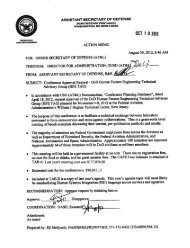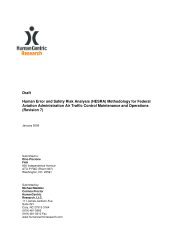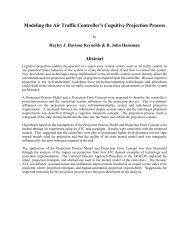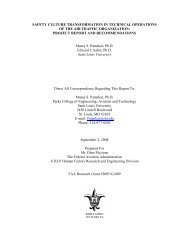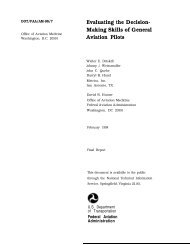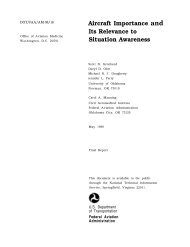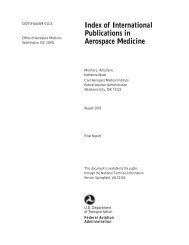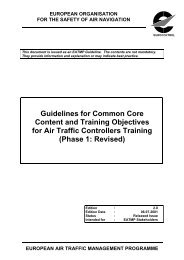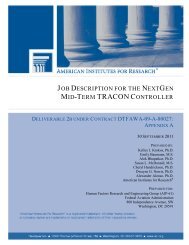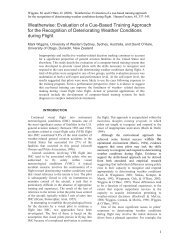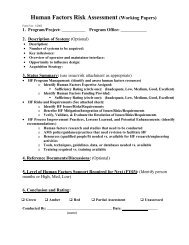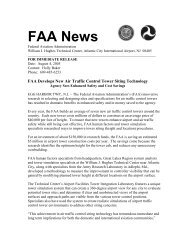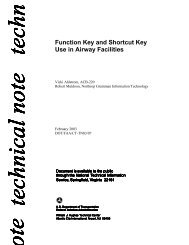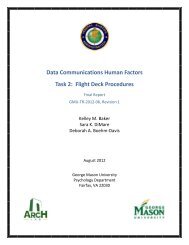job description for the nextgen mid-term atct controller - FAA Human ...
job description for the nextgen mid-term atct controller - FAA Human ...
job description for the nextgen mid-term atct controller - FAA Human ...
You also want an ePaper? Increase the reach of your titles
YUMPU automatically turns print PDFs into web optimized ePapers that Google loves.
and efficiently, <strong>the</strong>y more effectively manage <strong>the</strong>ir resources. This is an important <strong>job</strong><br />
responsibility and it is covered in <strong>the</strong> next Activity.<br />
Current ATCT Activity 10: Manage Resources<br />
ATCT line <strong>controller</strong>s are responsible <strong>for</strong> ensuring that <strong>the</strong> levels of per<strong>for</strong>mance at <strong>the</strong>ir<br />
positions are maintained to a consistently high standard. To do this, <strong>the</strong>y must identify and<br />
respond to threats to <strong>the</strong>ir personal and position resources, such as overload situations.<br />
First and <strong>for</strong>emost, ATCT line <strong>controller</strong>s must evaluate whe<strong>the</strong>r <strong>the</strong>y are fit <strong>for</strong> duty. If not,<br />
<strong>the</strong>y must notify <strong>the</strong>ir supervisor, even if <strong>the</strong>y can continue to work in a limited capacity. After<br />
<strong>the</strong>y are on position, <strong>controller</strong>s must remain in constant communication with o<strong>the</strong>r <strong>controller</strong>s<br />
and supervisors to recognize when traffic reaches overload or saturation levels. These conditions<br />
limit <strong>the</strong> effectiveness of <strong>the</strong> work environment as a whole. During <strong>the</strong>se high workload periods,<br />
voice frequencies can become dangerously congested and important safety rules can be violated<br />
as a result. Traffic managers and supervisors work with line <strong>controller</strong>s to implement an<br />
effective reduction strategy. Identifying and implementing <strong>the</strong>se strategies are key Tasks of <strong>the</strong><br />
<strong>controller</strong>’s <strong>job</strong>.<br />
Controllers must work as members of a highly functioning team. It is critical <strong>for</strong> <strong>controller</strong>s to<br />
maintain an overall tower awareness to provide assistance to fellow <strong>controller</strong>s if necessary. To<br />
achieve this awareness, <strong>controller</strong>s monitor nearby positions. Controllers must also remain<br />
proficient at <strong>the</strong> <strong>job</strong> by per<strong>for</strong>ming recurrent training exercises and adhering to safety standards<br />
requirements.<br />
Because <strong>the</strong> flow of traffic varies, it is important <strong>for</strong> ATCT line <strong>controller</strong>s to achieve and<br />
maintain balance in <strong>the</strong>ir workload and in <strong>the</strong>ir work environment. This is done to manage and<br />
mitigate <strong>the</strong> potential errors that could occur during periods of heavy or complex traffic when<br />
<strong>controller</strong>s are stretched to <strong>the</strong> limit of <strong>the</strong>ir per<strong>for</strong>mance capabilities.<br />
Current ATCT Activity 11: Respond to Emergencies and Unusual Situations<br />
Although redundancy is built into <strong>the</strong> systems in use by today’s ATCT <strong>controller</strong>s, <strong>the</strong>re is still<br />
<strong>the</strong> potential <strong>for</strong> unplanned outages and loss of functionality or service degradation. Because <strong>the</strong><br />
consequences of <strong>the</strong>se types of failures include <strong>the</strong> potential <strong>for</strong> loss of life, ATCT line<br />
<strong>controller</strong>s must be able to continue to provide control services to aircraft that are in <strong>the</strong>ir<br />
airspace at all times even if a problem or an unexpected situation occurs.<br />
Controllers must be well trained and proficient at executing several different contingency<br />
scenarios. First, <strong>controller</strong>s must detect failures and respond to alarms. They must <strong>the</strong>n <strong>for</strong>ward<br />
<strong>the</strong> notice of failure to supervisors and maintenance technicians and immediately implement<br />
appropriate backup procedure(s). If a data input failure is detected, <strong>controller</strong>s must receive and<br />
<strong>for</strong>ward data manually. If <strong>the</strong>re is a display failure, <strong>controller</strong>s must receive notice of and verify<br />
all computer actions during <strong>the</strong> transition from automated to manual stages. For <strong>the</strong> Host<br />
computer system (i.e., Host and Oceanic Computers System Replacement or HOCSR) failures,<br />
<strong>controller</strong>s must revert to ARTS stand-alone mode and manual writing of flight progress strip<br />
in<strong>for</strong>mation. Controllers must also revert to nonradar procedures <strong>for</strong> sensor or tracking failures.<br />
Finally, if a communication failure is detected, <strong>controller</strong>s must switch to a backup radio or<br />
26



